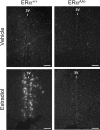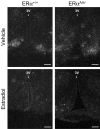Regulation of Kiss1 and dynorphin gene expression in the murine brain by classical and nonclassical estrogen receptor pathways
- PMID: 19625529
- PMCID: PMC2819182
- DOI: 10.1523/JNEUROSCI.0763-09.2009
Regulation of Kiss1 and dynorphin gene expression in the murine brain by classical and nonclassical estrogen receptor pathways
Abstract
Kisspeptin is a product of the Kiss1 gene and is expressed in the forebrain. Neurons that express Kiss1 play a crucial role in the regulation of pituitary luteinizing hormone secretion and reproduction. These neurons are the direct targets for the action of estradiol-17beta (E(2)), which acts via the estrogen receptor alpha isoform (ER alpha) to regulate Kiss1 expression. In the arcuate nucleus (Arc), where the dynorphin gene (Dyn) is expressed in Kiss1 neurons, E(2) inhibits the expression of Kiss1 mRNA. However, E(2) induces the expression of Kiss1 in the anteroventral periventricular nucleus (AVPV). The mechanism for differential regulation of Kiss1 in the Arc and AVPV by E(2) is unknown. ER alpha signals through multiple pathways, which can be categorized as either classical, involving the estrogen response element (ERE), or nonclassical, involving ERE-independent mechanisms. To elucidate the molecular basis for the action of E(2) on Kiss1 and Dyn expression, we studied the effects of E(2) on Kiss1 and Dyn mRNAs in the brains of mice bearing targeted alterations in the ER alpha signaling pathways. We found that stimulation of Kiss1 expression by E(2) in the AVPV and inhibition of Dyn in the Arc required an ERE-dependent pathway, whereas the inhibition of Kiss1 expression by E(2) in the Arc involved ERE-independent mechanisms. Thus, distinct ER alpha signaling pathways can differentially regulate the expression of identical genes across different brain regions, and E(2) can act within the same neuron through divergent ER alpha signaling pathways to regulate different neurotransmitter genes.
Figures






References
-
- Bodo C, Kudwa AE, Rissman EF. Both estrogen receptor-alpha and -beta are required for sexual differentiation of the anteroventral periventricular area in mice. Endocrinology. 2006;147:415–420. - PubMed
-
- Chowen JA, Argente J, Vician L, Clifton DK, Steiner RA. Pro-opiomelanocortin messenger RNA in hypothalamic neurons is increased by testosterone through aromatization to estradiol. Neuroendocrinology. 1990;52:581–588. - PubMed
-
- Couse JF, Korach KS. Estrogen receptor null mice: what have we learned and where will they lead us? Endocr Rev. 1999;20:358–417. - PubMed
-
- Cunningham MJ, Scarlett JM, Steiner RA. Cloning and distribution of galanin-like peptide mRNA in the hypothalamus and pituitary of the macaque. Endocrinology. 2002;143:755–763. - PubMed
Publication types
MeSH terms
Substances
Grants and funding
LinkOut - more resources
Full Text Sources
Other Literature Sources
Molecular Biology Databases
